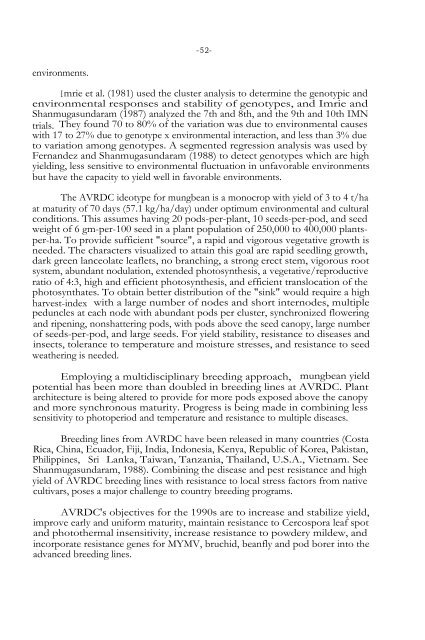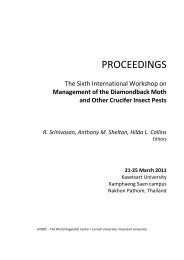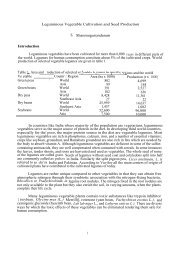MUNGBEAN VARIETAL IMPROVEMENT S. Shanmugasundaram
MUNGBEAN VARIETAL IMPROVEMENT S. Shanmugasundaram
MUNGBEAN VARIETAL IMPROVEMENT S. Shanmugasundaram
Create successful ePaper yourself
Turn your PDF publications into a flip-book with our unique Google optimized e-Paper software.
-52-<br />
environments.<br />
Imrie et al. (1981) used the cluster analysis to determine the genotypic and<br />
environmental responses and stability of genotypes, and Imrie and<br />
<strong>Shanmugasundaram</strong> (1987) analyzed the 7th and 8th, and the 9th and 10th IMN<br />
trials. They found 70 to 80% of the variation was due to environmental causes<br />
with 17 to 27% due to genotype x environmental interaction, and less than 3% due<br />
to variation among genotypes. A segmented regression analysis was used by<br />
Fernandez and <strong>Shanmugasundaram</strong> (1988) to detect genotypes which are high<br />
yielding, less sensitive to environmental fluctuation in unfavorable environments<br />
but have the capacity to yield well in favorable environments.<br />
The AVRDC ideotype for mungbean is a monocrop with yield of 3 to 4 t/ha<br />
at maturity of 70 days (57.1 kg/ha/day) under optimum environmental and cultural<br />
conditions. This assumes having 20 pods-per-plant, 10 seeds-per-pod, and seed<br />
weight of 6 gm-per-100 seed in a plant population of 250,000 to 400,000 plantsper-ha.<br />
To provide sufficient "source", a rapid and vigorous vegetative growth is<br />
needed. The characters visualized to attain this goal are rapid seedling growth,<br />
dark green lanceolate leaflets, no branching, a strong erect stem, vigorous root<br />
system, abundant nodulation, extended photosynthesis, a vegetative/reproductive<br />
ratio of 4:3, high and efficient photosynthesis, and efficient translocation of the<br />
photosynthates. To obtain better distribution of the "sink" would require a high<br />
harvest-index with a large number of nodes and short internodes, multiple<br />
peduncles at each node with abundant pods per cluster, synchronized flowering<br />
and ripening, nonshattering pods, with pods above the seed canopy, large number<br />
of seeds-per-pod, and large seeds. For yield stability, resistance to diseases and<br />
insects, tolerance to temperature and moisture stresses, and resistance to seed<br />
weathering is needed.<br />
Employing a multidisciplinary breeding approach, mungbean yield<br />
potential has been more than doubled in breeding lines at AVRDC. Plant<br />
architecture is being altered to provide for more pods exposed above the canopy<br />
and more synchronous maturity. Progress is being made in combining less<br />
sensitivity to photoperiod and temperature and resistance to multiple diseases.<br />
Breeding lines from AVRDC have been released in many countries (Costa<br />
Rica, China, Ecuador, Fiji, India, Indonesia, Kenya, Republic of Korea, Pakistan,<br />
Philippines, Sri Lanka, Taiwan, Tanzania, Thailand, U.S.A., Vietnam. See<br />
<strong>Shanmugasundaram</strong>, 1988). Combining the disease and pest resistance and high<br />
yield of AVRDC breeding lines with resistance to local stress factors from native<br />
cultivars, poses a major challenge to country breeding programs.<br />
AVRDC's objectives for the 1990s are to increase and stabilize yield,<br />
improve early and uniform maturity, maintain resistance to Cercospora leaf spot<br />
and photothermal insensitivity, increase resistance to powdery mildew, and<br />
incorporate resistance genes for MYMV, bruchid, beanfly and pod borer into the<br />
advanced breeding lines.

















